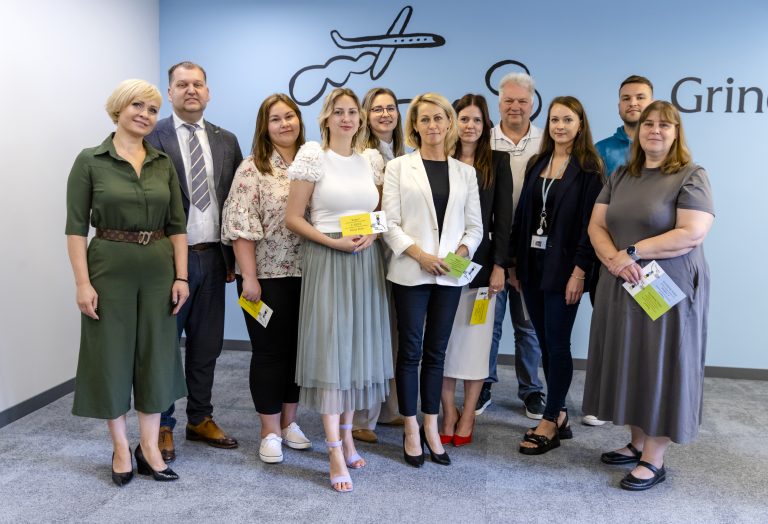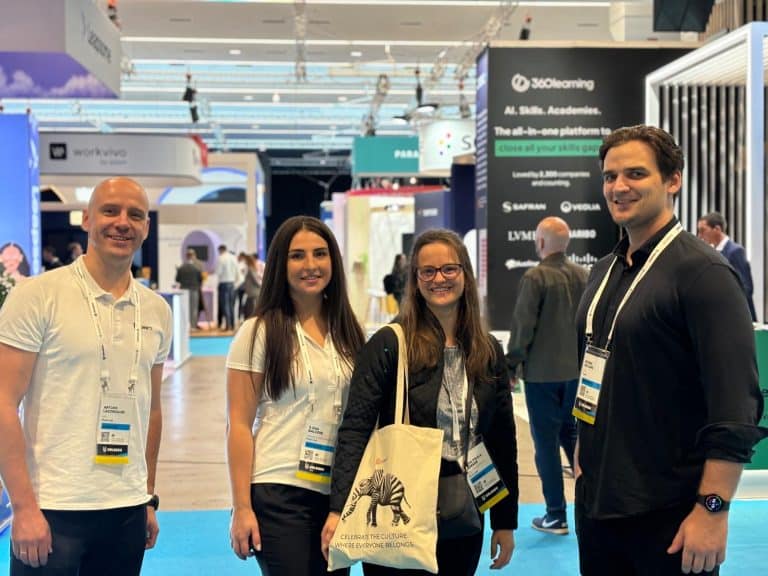To better understand how organisations have been adapting to the concept of hybrid workplace, we welcomed Jurgita Gaukštė to share her thinking and observations.
Jurgita Gaukštė is culture, values and leadership organisational consultant and founder of „Sąmoninga lyderystė”. Jurgita’s consulting projects have been carried out in Lithuanian and international companies in the following sectors: energy, finance, logistics, IT, law, hospitality, non-profit organisations, government agencies, educational institutions.
The interview was conducted through email correspondence, all the responses are direct answers from Jurgita Gaukštė.
1. The trend of hybrid workplace has changed very rapidly in recent years, starting with the impact of the pandemic. In your experience, what is the current attitude towards hybrid work in the eyes of employers and employees?
“Before the pandemic, many organisations practised working from an office. During the pandemic, many were forced to leave their offices and work remotely. It seems to me that recontracting is still going on – organisations are still looking for a new arrangement. I’ve observed cases where workers refuse to work in the office even one day a week. I’ve observed cases where the employer sets a strict rule that everyone must work only from the office. We are living in a time when individualism is on the rise, but the organisation is a community. An organisation will only function sustainably if an agreement is found that is sufficiently attuned to the needs of both the individual and the organisation. It will therefore be necessary to experiment and reflect for some time until a mutually satisfactory solution is found.”
2. What role does organizational culture play in successfully implementing and sustaining a hybrid workplace?
“Organisational workspace is experiential space. The experience is shaped not only by a tangible and physical space, but also by social and digital space. Even though experience at work and organisational culture are not easy to measure, culture has a significant impact on how well an organisation performs and whether it is a good place to work. The 2022 UK Business Values Survey showed that developing culture and values increases commercial success, helps implement strategy, increases organisational alignment and customer satisfaction, improves reputation, and helps attract talent.
Culture consists of visible and tangible artefacts, the physical environment, the office, traditions, the behaviour of colleagues that can be observed in the office, and invisible elements such as values, agreed behaviours, leadership, and decision-making. Hybrid working often leaves behind the physical environment and the tangible artefacts, and the invisible elements of culture become more important. Therefore, time and resources must be purposefully devoted to the creation of culture. Cultural development does not happen automatically in a hybrid workplace, where some employees work remotely, some in the office and often they do not meet each other.
With the external context changing so rapidly, employees’ experience of the organisation is created in very different environments: working from home, in different countries, on different platforms, they have different conditions and therefore experience the organisation differently and see a fragmented picture of it. It is important to periodically assess the current culture, the values that are relevant and in line with the organisation’s current reality and direction. It is important not only to study the culture, but also to organise dialogue sessions so that there is not only a quantitative assessment, but also qualitative information, making sense of the research data and what it means for the organisation. For example, I recently facilitated a values session in one organisation. One participant surprised her colleagues by asking out loud, with some frustration, “What kind of organisation are you talking about here? I feel as if I work for a completely different organisation.” In most cases, an organisation is more diverse than any one department or employee imagines. It is very important to be aware of the diversity of your organisation, to get to know it, because when employee knows organisation well, she/he can make much more effective decisions that are more relevant to the context of the organisation and have a greater impact.”
3. How can organizations effectively manage and maintain a sense of team cohesion and collaboration in a hybrid work setting?
“I would like to highlight some of the challenges that organisations face when moving towards a hybrid working environment:
- Collaboration
- Communication and engagement.
- 3. Performance evaluation and role-task clarity.
- Leadership.
Collaboration
According to The 2022 UK Business Values Survey, collaboration has become the most important value that organisations choose to foster. In the time span of 7 years, I’ve conducted many culture and values surveys in Lithuania using “Barrett Values Centre” methodology. Now it is more than 6000 people who filled in these surveys in different organisations. From the research, I’ve concluded that Collaboration is identified as one of the most important values in organisations. The importance of collaboration has increased due to the challenges in the environment: pandemics, war and digitalisation, and of course hybrid working models: where greater cohesion is needed to overcome challenges. It is important for teams to agree on the time and space they are willing to allocate to talk about their culture, to get to know themselves and their team members and to agree on common goals, how they want to work and what values to foster.
Communication and Engagement
A hybrid working model makes employee engagement more challenging. The hybrid working model allows for a wide variety of choices in the way work is done. It is possible to work only remotely, it is possible to combine working from home with working in the office, and some employees have no choice but to work only on site due to the nature of their work. For example, in the logistics sector, engineering, construction, retail or some service sectors. There are additional tensions around equal opportunities: on-site employees have less freedom of choice, often must use after work hours to access on-the-job training, less opportunities to get involved. For example, an office worker is used to spending more time online in front of a computer, where part of the time can be devoted to learning and familiarising oneself with the organisation’s communication. On the other hand, the on-site employee often checks his/her email after working hours or does not always have possibility to access company-purchased online training after working hours. It is important to note that these inequalities are occurring and to seek solutions.
Organisations often underestimate the extra effort and resources that will be needed for communication in hybrid work. I observe that sometimes it is difficult to involve less technologically literate or on-site staff when doing an online culture survey in organisations. One HR manager described how she took her laptop to some of employees and sat down with them to complete the survey, while others preferred to engage through paper questionnaires.
Another important point is that the variety of technological tools both helps and hinders communication. In one creative industries organisation, different teams listed the different tools they use in their daily communication: Email, Teams, Slack, Messenger and other internal platforms. Everyone is free to choose their own communication tool, but it is a real challenge to ensure a unified communication and employee engagement from organisational perspective.”
Performance evaluation and role-task clarity
“86% of employees say they want to work for a company that prioritizes outcomes over output” (i.e. they want their work to be measured by the added value they bring rather than the number of emails they send or hours they work)1.
Reality is often quite complex, full of uncertainties and competing interests. Therefore, the outcome and the output (how outcome is achieved) are often equally important. For example, a change manager was employed to drive big and complex engineering project in logistics infrastructure. She worked remotely or in the office, but she needed input from employees working on site. She was disappointed by not getting back emails from them, not getting their professional input for the project. Employees from onsite were disappointed by office people not recognizing their difficult work, not coming to the site to see what the real context is and to make human connection. So even working remotely, it is important to plan face-to-face visits and meetings. It significantly increases commitment, trust, and productivity, but is more difficult to evaluate.
The boundaries of the hybrid work are not yet clear, and there is a process of negotiation on how to understand the boundaries of working hours, what constitutes a good outcome in each role, what platforms employees use, for what purposes. ReconstructionRenegotiation of boundaries is important for employees’ work-life balance and to ensure a healthy socio-emotional environment; this is why the importance of managers’ emotional competence is growing rapidly. In a hybrid workplace, it is important to agree on what will be done face-to-face and what will be done through technological tools. Humans have an innate need to protect themselves, and from complex emotional experiences too. There is a risk of using technological tools instead of live contact to effectively manage change, crises, to deliver corrective feedback, onboarding, etc. It is important not to be seduced by simplified thinking; these cases require human dialogue, exploration of different points of view, making sense of events.
Leadership
Management must adapt their leadership styles into more collaborative one. There is a need for higher psychological maturity to solve complex issues, to understand how digital workspace affects social and emotional climate at work. Periodic group supervisions for managers in psychologically mature organisations is a strong tool. Managers bring real-life challenging cases from different parts of the organisation and, with the help of their colleagues, explore what happened in that case, what was the group dynamic, and what was the impact of decision on other people. In this way, managers improve their emotional intelligence and empathy, learn to think psychologically and to see beyond the technical side of a situation. They gain better understanding of the importance of the social-emotional environment, which is very important in hybrid workplaces. Managers learn to access not only technical but also emotional information for their decision-making, which is also an important part of organisational reality.”
Concluding Note
In conclusion, I would like to highlight a few important things that help to improve collaboration and develop culture in a hybrid environment:
– A company must periodically assess the culture and organise sessions of dialogue with employees. To ensure that employees that work in very different environments know their company’s culture better and can work more effectively within it. I often use the Barrett Values Centre culture and values assessment to conduct different assessments. In addition, it is very important to have an open face-to-face dialogue, which brings in qualitative information. Tools such as Peero help to shape culture, raise awareness of values, engage with and recognize colleagues. It is important to use technological tools and to maintain live contact and dialogue.
– While working remotely it is important to plan face-to-face visits and meetings. As it significantly increases commitment, trust and productivity. It is important for better understanding of context and being in touch with reality.
– The boundaries of the hybrid workplace are not yet clear, and there is a lot of unclarity how to understand the limits of working hours, how to assess performance in each role, what platforms employees use and for what purposes. In hybrid workspace, it is important to agree on what will be done live and what will be done through technological tools. As the digital working environment changes, it is important to consider how the social-emotional working environment will change.
– Agreement on how to ensure a healthy socio-emotional environment is crucial, and the importance of managers’ psychological maturity and emotional competence in a workplace is growing rapidly. Group sessions reflecting organisation as a system are important because, in a hybrid workplace, the group helps to see the organisation as a whole rather than a fragmented entity. Managers learn to access not only technical but also emotional information for their decision-making, which is also an important part of organisational reality.

Reference
- https://www.aihr.com/blog/hybrid-work-strategic-opportunities/.
To dive in further, read more on Hybrid Workplace in other Peero articles:
❗️If you want even more useful information about organizational culture, values and leadership topics, we recommend you to visit Samoninga Lyderystė Blog.




